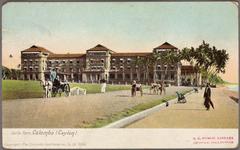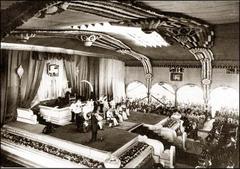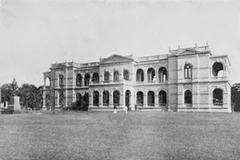
Yugadanavi Power Station: Visiting Hours, Tickets, and Colombo District Historical Sites Guide
Date: 04/07/2025
Introduction
The Yugadanavi Power Station, also known as the Kerawalapitiya Power Station, stands as a cornerstone of Sri Lanka’s modern energy infrastructure. Located in the Hendala and Kerawalapitiya areas of Colombo District, this 300 MW combined cycle thermal power plant was commissioned in the late 2000s and became fully operational in 2010. Developed to address the rising electricity demand and diversify the country’s energy mix, Yugadanavi symbolizes Sri Lanka’s transition from hydropower and imported oil toward cleaner and more efficient energy sources.
This guide offers a comprehensive overview of the power station’s history, engineering and financing, ongoing transition to liquefied natural gas (LNG), and practical visitor information. It also highlights nearby attractions in Colombo District for those interested in combining industrial and cultural exploration. For background and the latest updates, consult the Wikipedia page on Yugadanavi Power Station and the Power Technology profile.
Table of Contents
- Historical Background and Development
- Construction, Technology, and Financing
- Transition to Cleaner Energy and Recent Developments
- Political and Social Dynamics
- Visitor Information and Guidelines
- Nearby Attractions in Colombo District
- Frequently Asked Questions (FAQ)
- Summary and Travel Tips
- References
Historical Background and Development
Early Development and Strategic Context
The Yugadanavi Power Station was conceived in the mid-2000s to bolster Sri Lanka’s electricity supply and reduce dependence on hydropower and imported oil. Frequent power shortages, particularly during droughts, highlighted the need for reliable thermal generation. The government and the Ceylon Electricity Board (CEB) spearheaded the project, selecting the Kerawalapitiya site near Colombo for its proximity to the national grid, access to seawater for cooling, and logistical convenience for fuel delivery (Wikipedia; Power Technology).
Construction, Technology, and Financing
Timeline and Engineering Partners
Construction began in November 2007, unfolding in two main phases:
- Phase 1: Installation of two 100 MW General Electric (GE) Frame 9E gas turbines, completed in 10 months and inaugurated in December 2008.
- Phase 2: Addition of a 100 MW GE steam turbine, completing the combined cycle configuration by February 2010 and bringing capacity to 300 MW.
Lakdhanavi, a subsidiary of LTL Holdings, managed the engineering, procurement, and construction (EPC) contract (FT.lk). Key technology partners included GE Power for turbines and NEM Modular HRSG Systems for heat recovery steam generators.
Financing Structure
The project’s total cost was approximately US$300 million, funded through both debt and equity:
- Debt: €152 million arranged by HSBC, supported by export credit agencies from several countries, ensuring attractive loan terms.
- Equity: West Coast Power Ltd. (a subsidiary of Lanka Transformers Ltd.) is the plant owner, with the Sri Lankan Treasury (via CEB) holding a majority stake (FT.lk; Wikipedia).
Transition to Cleaner Energy and Recent Developments
LNG Conversion and Foreign Investment
A pivotal chapter in Yugadanavi’s evolution began in 2021, when New Fortress Energy (NFE), a US-based company, acquired a 40% stake in West Coast Power Ltd. for approximately US$350 million. The deal included development rights for an offshore LNG receiving, storage, and regasification terminal off Colombo’s coast (FT.lk). The transition to LNG is central to Sri Lanka’s strategy to reduce carbon emissions, lower fuel costs, and improve energy security (Wikipedia).
Infrastructure and Operations
The LNG supply will be handled via a floating storage and regasification unit (FSRU) offshore, with gas delivered through an undersea pipeline. This move aligns with the country’s Long-Term Generation Expansion Plan (LTGEP) 2023–2042, aiming to convert major thermal plants to natural gas by 2025.
The plant operates under a long-term power purchase agreement, ensuring reliable electricity supply through at least 2035 (Island.lk).
Political and Social Dynamics
The partial sale of Yugadanavi and the LNG infrastructure agreement generated significant political discussion. Critics raised concerns about procurement transparency and national energy security, while the government defended the deal as essential for attracting investment and modernizing the power sector (Ada Derana; FT.lk).
Visitor Information and Guidelines
Can You Visit the Yugadanavi Power Station?
As a critical infrastructure facility, Yugadanavi is not open for general public tourism. However, the plant occasionally accommodates educational groups, researchers, or professionals with prior authorization from the Ceylon Electricity Board (CEB) (Ceylon Electricity Board official website).
Arranging a Visit
- Contact: CEB official visiting guidelines
- Booking: Requests must be made in advance and are subject to approval.
- Required Information: Purpose of visit, group details, and any special access needs.
Visiting Hours
- Authorized visits: Typically scheduled Monday to Friday, 9:00 AM to 4:00 PM (excluding public holidays and weekends).
Safety and Accessibility
- Safety: All visitors must comply with strict safety protocols, including wearing provided personal protective equipment (PPE).
- Accessibility: The facility has basic accessibility features, but visitors with specific needs should inform CEB in advance.
Tickets and Fees
- Entry: There are no standard ticketing arrangements. Any fees or requirements are determined during the official booking process.
Photography and Conduct
- Photography: Generally restricted; explicit permission required.
- Conduct: Visitors must always be accompanied by guides and follow all instructions.
Nearby Attractions in Colombo District
While the Yugadanavi Power Station is an industrial site, the surrounding area offers several attractions for a broader Colombo experience:
- Kelaniya Raja Maha Vihara: A prominent Buddhist temple, about 10 km from Kerawalapitiya.
- Hendala Industrial Zone: Insight into Sri Lanka’s industrial landscape.
- Colombo City Center: Museums, shopping, dining, and cultural sites.
- Kelani River: Scenic areas ideal for relaxation or photography.
Combining an authorized visit to Yugadanavi with these destinations provides a well-rounded perspective of Colombo’s heritage and modern advancements.
Frequently Asked Questions (FAQ)
Q1: Can the public visit the Yugadanavi Power Station?
A1: No, general public access is not permitted. Educational or official group visits require prior authorization from the CEB.
Q2: What are the visiting hours and booking procedures?
A2: Visits, if approved, are scheduled on weekdays during working hours. Contact the CEB to initiate bookings.
Q3: What fuels does the plant use?
A3: The plant was originally designed for diesel and oil but is transitioning to use primarily LNG.
Q4: Who owns the power station?
A4: West Coast Power Ltd. (a subsidiary of Lanka Transformers Ltd.) owns the plant, with the Sri Lankan Treasury (via CEB) holding a majority stake.
Q5: Is the facility accessible for people with disabilities?
A5: Basic accessibility features exist, but visitors with specific needs should confirm details with CEB when arranging a visit.
Q6: Are there facilities like restrooms or refreshments on-site?
A6: Basic restrooms are available. No food or refreshments are provided; plan accordingly.
Q7: Is photography allowed?
A7: Photography is generally restricted and must be approved by plant authorities.
Summary and Travel Tips
The Yugadanavi Power Station stands as a major milestone in Sri Lanka’s journey toward sustainable and efficient energy. Its development stabilized national power supply, especially in the Western Province, and set the stage for future public-private partnerships in the energy sector. The ongoing transition to LNG is expected to cut fuel costs and emissions, reinforcing Sri Lanka’s environmental and economic objectives.
Visitor Tips:
- Arrange visits well in advance through official channels.
- Adhere to all safety and security guidelines.
- Combine your visit with cultural or historical sites in Colombo for a comprehensive experience.
For the latest updates, visitor protocols, and insights into Sri Lanka’s energy sector, consult official resources such as the Ceylon Electricity Board and reputable news portals.
References and Further Reading
- Yugadanavi Power Station (Wikipedia)
- Kerawalapitiya Yugadanavi Combined Cycle Power Plant Profile (Power Technology)
- Govt’s deal with Kerawalapitiya power plant and American firm: Pros and Cons (FT.lk)
- US energy firm New Fortress and Govt sign definitive deal (FT.lk)
- Govt’s allied parties to convene meeting on Yugadanavi Power Plant deal (Ada Derana)
- Acquisition of Yugadanavi Power Plant and right to build new LNG terminal: US firm says agreement finalized (Island.lk)
- Ceylon Electricity Board official website
- Ceylon Electricity Board official visiting guidelines






